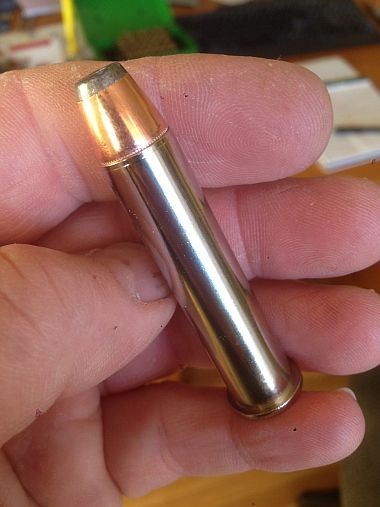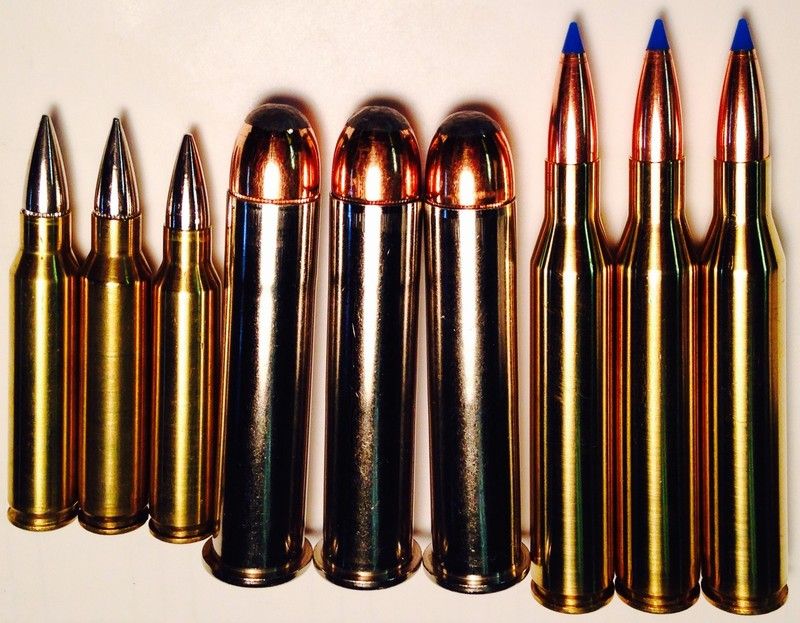You are using an out of date browser. It may not display this or other websites correctly.
You should upgrade or use an alternative browser.
You should upgrade or use an alternative browser.
Reloading 45-70
- Thread starter Wendyj
- Start date
...and 4198 has been available in quantity for months now, as has 3031. It's unusual to see a single propellant 'stick' on the shelves like these have, so I reckon no one is worried about not being able to load enough .45-70 to weather the apocalypse. While 3031 may not be your go-to powder for moderate .45-70, it sure seems you'd be hard-pressed to do much better than 4198 at least if load data is an indicator. Should buffalo become a serious threat anytime soon, I know I'm covered as far as shooting at them goes.
Apparently to hit them though, I'll need to be able to smell 'em first.
...and while substance is always more attractive than trimmings alone, I enjoy putting together a few 'presentation' rounds just for looking at and fondling when range days are so far, far away. Being able to do so for far less than the cost of factory adds a certain warmth in itself:

Apparently to hit them though, I'll need to be able to smell 'em first.
...and while substance is always more attractive than trimmings alone, I enjoy putting together a few 'presentation' rounds just for looking at and fondling when range days are so far, far away. Being able to do so for far less than the cost of factory adds a certain warmth in itself:

Last edited:
Thanks Keybear. I've loaded and shot about 6 of my own. The IMR 3031 is shooting tighter groups than my factory and seems to be levering and ejecting well. Was a little Leary of the crimp when starting but got great help on here. Crimped okay but I wasn't sure how much. Didn't want to over pressure. So far so good.
condor bravo
New member
Keybear:
It sounds like you are suggesting jumping into bullet casting which is a different enterprise as you know. Could be a good idea to add a bullet for the .45-70 if you are already into casting, but might never be beneficial if casting for just one rifle bullet. At the very least one should obtain and try out commercial cast bullets to make sure they are to your liking. There are several good sources available for a large variety of cast rifle bullets and are not that expensive. A quantity of cast rifle bullets will generally go farther than the same quantity of handgun bullets but at a somewhat higher price. Previously I would recommend without hesitation that bullet casting would be the beneficial way to go, but with salvage lead harder to come by, and the cost of equipment, that may not be such a good idea. Yes, you can get by with less equipment but who wouldn't want the RCBS bottom pour furnace?
It sounds like you are suggesting jumping into bullet casting which is a different enterprise as you know. Could be a good idea to add a bullet for the .45-70 if you are already into casting, but might never be beneficial if casting for just one rifle bullet. At the very least one should obtain and try out commercial cast bullets to make sure they are to your liking. There are several good sources available for a large variety of cast rifle bullets and are not that expensive. A quantity of cast rifle bullets will generally go farther than the same quantity of handgun bullets but at a somewhat higher price. Previously I would recommend without hesitation that bullet casting would be the beneficial way to go, but with salvage lead harder to come by, and the cost of equipment, that may not be such a good idea. Yes, you can get by with less equipment but who wouldn't want the RCBS bottom pour furnace?
condor bravo
No just a mistake on my part . I would never cast bullets or ask anyone else to start . Casting needs extra care to be done safely to me it is just to easy to buy bullets . I know people that cast bullets with little thought of the dangers ( this was years ago .) Some of the people were friends and some died early . Just me but if you or any else goes into casting the right way fine . It can be a problem and I find it easer to buy bullets . Also I can be shooting not casting .
No just a mistake on my part . I would never cast bullets or ask anyone else to start . Casting needs extra care to be done safely to me it is just to easy to buy bullets . I know people that cast bullets with little thought of the dangers ( this was years ago .) Some of the people were friends and some died early . Just me but if you or any else goes into casting the right way fine . It can be a problem and I find it easer to buy bullets . Also I can be shooting not casting .
condor bravo
New member
Keybear:
Roger on your reply; completely agree. Couldn't really tell if you were advocating jumping into casting or not. Much easier to buy cast rifle bullets; my main sources now are Montana Bullet Works and Western Bullet Company, also in Montana. There are other good sources. I did cast handgun bullets for some 40 years but gave it up when cheap lead became hard to acquire. Started out with a free SAECO electric bottom feed furnace and .38 and .45 bullet molds and progressed from there to more elaborate equipment and up to 20 bullet types over several calibers. That of course made the endeavor beneficial and easily paid for itself many times over. But right now would not recommend that someone jump in cold for bullet casting. And there can be some danger attached to it but never suffered anything worse than minor lead splatter when pouring damp lead into the furnace. I guess my worst thoughts were the support posts giving away on the 22 pound RCBS bottom feed furnace and dumping the contents on your lap. Then if using spent bullet lead from a shooting range, there is the possibility of dumping a live round into the pot. Extreme care must be used to carefully examine firing range lead before using. I did find a few live rounds.
Roger on your reply; completely agree. Couldn't really tell if you were advocating jumping into casting or not. Much easier to buy cast rifle bullets; my main sources now are Montana Bullet Works and Western Bullet Company, also in Montana. There are other good sources. I did cast handgun bullets for some 40 years but gave it up when cheap lead became hard to acquire. Started out with a free SAECO electric bottom feed furnace and .38 and .45 bullet molds and progressed from there to more elaborate equipment and up to 20 bullet types over several calibers. That of course made the endeavor beneficial and easily paid for itself many times over. But right now would not recommend that someone jump in cold for bullet casting. And there can be some danger attached to it but never suffered anything worse than minor lead splatter when pouring damp lead into the furnace. I guess my worst thoughts were the support posts giving away on the 22 pound RCBS bottom feed furnace and dumping the contents on your lap. Then if using spent bullet lead from a shooting range, there is the possibility of dumping a live round into the pot. Extreme care must be used to carefully examine firing range lead before using. I did find a few live rounds.
Last edited:
I knew someone would be coming along ?
And the dangers are... ?
(beyond that of common sense)
And that is the very reason . People like to do things on the cheap some times doing things in not the best way ?
Your comment shows just that are you saying lets cast bullets in the bathroom . If you do not know the dangers do not cast bullets .
And if you are casting now maybe you need to rethink how .
Yes casting CAN be done safely but how many hobby bullet casters watch there lead blood levels ?
And the dangers are... ?
(beyond that of common sense)
And that is the very reason . People like to do things on the cheap some times doing things in not the best way ?
Your comment shows just that are you saying lets cast bullets in the bathroom . If you do not know the dangers do not cast bullets .
And if you are casting now maybe you need to rethink how .
Yes casting CAN be done safely but how many hobby bullet casters watch there lead blood levels ?
Huh?And the dangers are... ?
(beyond that of common sense)
Your comment shows just that are you
saying lets cast bullets in the bathroom.
That's quite a stretch.
Shirley you jest. *
* and don't call be Shirley
keybear said:Yes casting CAN be done safely but how many hobby bullet casters watch there lead blood levels ?
At least one.
Started casting here in the early 1990's, so been doing it almost 25 years now.
Had them add a blood test for lead to my annual physical last year. Came back at 3 micrograms/dl. I was told that normal is less than 20, exposure to lead should be less than 40, and 60 is considered lead poisoning.
Shouldn't be any problem unless you like the taste of bullets.
how many hobby bullet casters watch there lead blood levels?
I did, when I was casting. Will do so again, if I get set up to cast, again.
WENDY J, sorry for the tardive reply. I know that Reloder7 works in .45-70, but I'm not certain how well it works over a wide range of projectile weights. The thing about the .45-70 is, propellants as different as Unique and IMR-4320 seem to give anywhere from acceptable to outstanding results.
I should have been more persistent about learning of your current propellant inventory. I found some other loads, worked up in a Winchester 1886, which may give you some guidance:
18.0-20.0/Unique/300 Cast: 1500 - 1680 f/s from a 26" barrel
30.0-33.0/ 2400 /300 Jacketed: @ 1600 f/s "
32.0-37.0/ 4227 /300 Jacketed: " "
14.0-17.0/Unique/350-400 Cast: 1200-1350 f/s "
22.0-32.0/ 2400 / " " " 1200-1700 f/s "
30.0-35.0/ 4227 / " " " 1300-1700 f/s "
If using cast data for jacketed bullets, I'D be inclined to reduce max loads by no more than 10%, to avoid sticking a jacketed projectile in the bore. Those more familiar with reloading .45-70 (I've reloaded 5 or 6 boxes) may have a more informed opinion on the matter.
I should have been more persistent about learning of your current propellant inventory. I found some other loads, worked up in a Winchester 1886, which may give you some guidance:
18.0-20.0/Unique/300 Cast: 1500 - 1680 f/s from a 26" barrel
30.0-33.0/ 2400 /300 Jacketed: @ 1600 f/s "
32.0-37.0/ 4227 /300 Jacketed: " "
14.0-17.0/Unique/350-400 Cast: 1200-1350 f/s "
22.0-32.0/ 2400 / " " " 1200-1700 f/s "
30.0-35.0/ 4227 / " " " 1300-1700 f/s "
If using cast data for jacketed bullets, I'D be inclined to reduce max loads by no more than 10%, to avoid sticking a jacketed projectile in the bore. Those more familiar with reloading .45-70 (I've reloaded 5 or 6 boxes) may have a more informed opinion on the matter.
Last edited:

